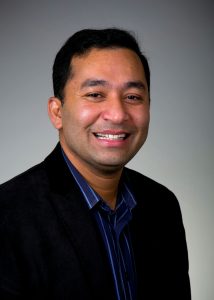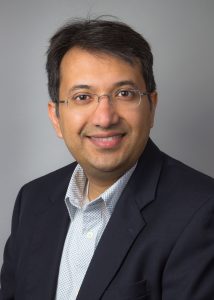
 Survey says: When asked whether most surgeries will be performed by computers in 2050, most medical school graduates said no, while most computing and engineering graduates said yes.
Survey says: When asked whether most surgeries will be performed by computers in 2050, most medical school graduates said no, while most computing and engineering graduates said yes.
In the late 1990s, Faisal Khan, Ph.D., and Masud Chowdhury, Ph.D., competed against each other in Bangladesh’s televised national debate championship. Khan’s team won, but only, Chowdhury says, because he didn’t compete in the final round.
More than two decades and 8,000 miles later, the two are still competing — not against each other, but against illnesses like cancer, heart disease and organ failure.
Khan and Chowdhury, both associate professors in the UMKC School of Computing and Engineering, form a biotechnology duo — with Khan specializing in energy harvesting, and Chowdhury in nanotechnology.
In simpler terms, the friends study how technology could save millions of lives.
The radio inside you
Imagine a system of wires running from your brain to your chest, monitoring everything from your heart rate to your chance of developing cancer. And if someone were looking at you, they wouldn’t even know it.
That’s the vision Khan wants to make a reality.
Picture this: Your blood pressure spikes unexpectedly. You feel nothing, but across town or across the country, your doctor gets a notification. Five minutes later, you’re scheduling an appointment.
This radio network would monitor everything from your heart rate to your chance of developing cancer. It could also improve outcomes for anyone with artificial limbs or organs. If a radio network inside the prosthetic could communicate with the brain, functionality would increase significantly.
The two major challenges, according to Khan, are getting electricity into the body safely, and making the technology compatible with MRI machines.
If those two challenges can be overcome, the opportunities are “endless.”
Nano-sized technology with huge results
While Khan’s radio network is monitoring your internal systems, Chowdhury’s microscopic sensors are coursing through your veins, delivering drugs to the exactly the cells that need it.
A nano-sized sensor placed inside the body could alert your doctor to a clogged artery, a low-battery pacemaker or a growing tumor. Then, a microscopic device would deliver drugs directly to the affected part of the body.
In the future, Chowdhury says, drug delivery will be dependent on this microelectronic and nanotechnology.
An especially promising use for this technology is treating cancer. One of the biggest problems with chemotherapy, Chowdhury explains, is how damaging it is to the body. The chemicals burn away cancerous cells, but as they move through your body, they destroy many healthy cells, as well.
Chowdhury knows this pain firsthand – his mother died of cancer.
“They lose all their hair, their skin becomes very pale … It’s a very painful process,” he says.
Nano-sized capsules could allow doctors to apply chemotherapy directly to the cancerous cells, rather than pumping it through the entire body.
Powering the body
How would these devices be powered, you ask? Researchers are exploring several charging methods, but there’s one idea patients would especially enjoy — a massage.
“I came up with an idea to send energy through vibration, in the form of a neck massage or a foot massage,” Khan says. “The vibration energy could be transferred to electronics inside the body.”
Much like you get a notification when your phone has low battery, patients will get a notification it is time to recharge.
Other ideas include thermal energy, chemical reactions and wireless charging.
Doctor robotics
Another breakthrough both Khan and Chowdhury predict: surgery performed via robotics.
Chowdhury imagines a future in which a doctor in Kansas City could perform surgery on a patient in Bangladesh using robotic arms. Another scenario would allow a machine to make a razor-straight cut on a patient, removing the possibility for human error.
But will doctors be out of the job? Not likely.
“Robotics will make it efficient and smooth for the doctor, but the doctor will never be replaced,” Chowdhury says. “The level and mode of involvement will change, but ultimately, human involvement will be there.”
Health care for all cultures
Chowdhury’s father was a physician with a mission – practice medicine in a rural area without access to health care.
There was just one problem: Some of the women refused to see him.
“The ladies from rural areas were very conservative because of their religious background,” Chowdhury says. “They would not talk about their medical conditions with a male doctor, so how were they going to get treatment?”
That’s when Chowdhury’s mother stepped in. She would talk to female patients about their symptoms, take copious notes, then relay everything to Chowdhury’s father.
“We used to joke with my mother that she had become a better doctor than my father,” Chowdhury says. “For a small little thing like an allergy or fever, my mother would never ask my father.”
Nanotechnology would allow these women to be tested for breast cancer and other diseases using high-resolution antennas that will maintain their physical privacy, much like an X-Ray or MRI.
“If you can come up with approaches and testing mechanisms that are not invasive, that will save millions of lives all across the world.”
Life-saving technology
The research Khan and Chowdhury are working on has the potential to reach every corner of the medical field — from treating cancer to diagnosing simple infections.
One of the lives saved could very well be another member of that Bangladeshi debate team: a friend of Khan and Chowdhury’s in Houston who needs a kidney transplant.
“What if we could come up with an artificial kidney that can run without external support for 10 years?” Chowdhury says. “So he doesn’t need to suffer for more than a year waiting for a donor?”
Both Khan and Chowdhury are optimistic about the strides being made in their fields.
Khan predicts we will see patients with internal radio networks within the next 10 years. Chowdhury is encouraged by the rate at which nanotechnology research is advancing around the world, especially in far Eastern and developing countries.
“When you have scientists and engineers from all over the world investing their knowledge, time, energy and interest, I think within our lifetime we will see significant breakthroughs,” Chowdhury says.
“The future is endless,” Khan says. “There is no limit.”
